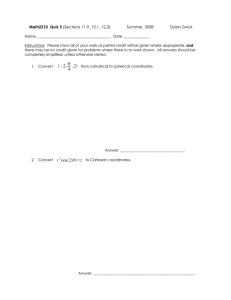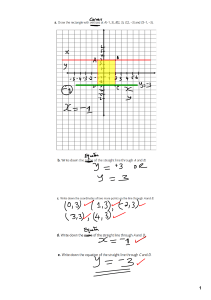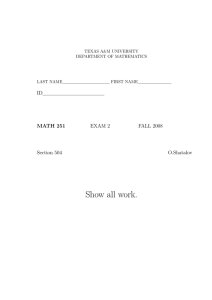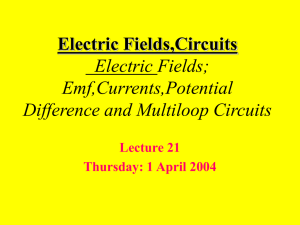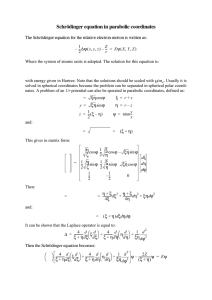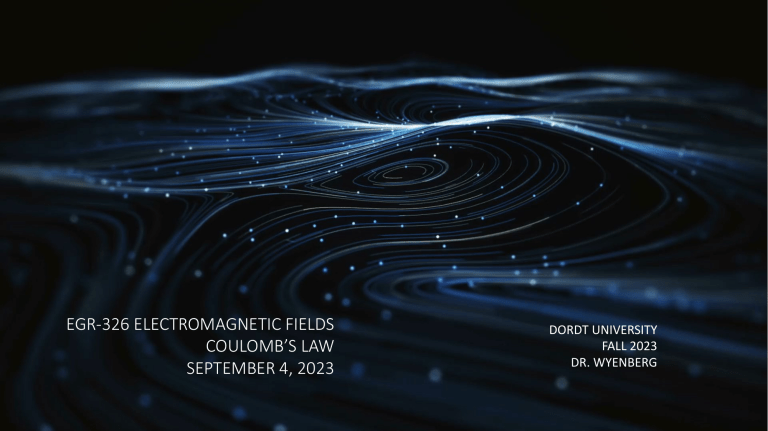
EGR-326 ELECTROMAGNETIC FIELDS COULOMB’S LAW SEPTEMBER 4, 2023 DORDT UNIVERSITY FALL 2023 DR. WYENBERG SPHERICAL CYLINDRICAL CARTESIAN 𝑟𝑟 𝜃𝜃 𝜙𝜙 SPHERICAL CYLINDRICAL CARTESIAN 𝑟𝑟 𝜌𝜌2 + 𝑧𝑧 2 𝑥𝑥 2 + 𝑦𝑦 2 + 𝑧𝑧 2 𝜃𝜃 𝜙𝜙 𝜌𝜌 𝑟𝑟 sin 𝜃𝜃 𝑧𝑧 𝑟𝑟 cos 𝜃𝜃 𝜙𝜙 tan−1 𝜙𝜙 𝜌𝜌 𝑧𝑧 𝜌𝜌 𝜙𝜙 𝜙𝜙 𝑥𝑥 𝑟𝑟 sin 𝜃𝜃 cos 𝜙𝜙 𝜌𝜌 cos 𝜙𝜙 𝑧𝑧 𝑟𝑟 cos 𝜃𝜃 𝑧𝑧 𝑦𝑦 𝑟𝑟 sin 𝜃𝜃 sin 𝜙𝜙 𝑧𝑧 𝜌𝜌 sin 𝜙𝜙 𝑥𝑥 2 + 𝑦𝑦 2 tan 𝑧𝑧 𝑦𝑦 −1 tan 𝑥𝑥 −1 𝑥𝑥 2 + 𝑦𝑦 2 tan−1 𝑧𝑧 𝑥𝑥 𝑦𝑦 𝑧𝑧 𝑦𝑦 𝑥𝑥 SPHERICAL SPHERICAL 𝑟𝑟̂ 𝜃𝜃̂ CARTESIAN CYLINDRICAL 𝜙𝜙� 𝜌𝜌� 𝜙𝜙� 𝑟𝑟̂ 𝜃𝜃� 𝜙𝜙� sin 𝜃𝜃 𝑟𝑟̂ + cos 𝜃𝜃 𝜃𝜃� CYLINDRICAL CARTESIAN 𝜌𝜌𝜌𝜌� + 𝑧𝑧𝑧𝑧̂ 𝑥𝑥 𝑥𝑥� + 𝑦𝑦𝑦𝑦� + 𝑧𝑧𝑧𝑧̂ 𝜌𝜌2 + 𝑧𝑧 2 𝑧𝑧𝜌𝜌� − 𝜌𝜌𝑧𝑧̂ 𝜌𝜌2 + 𝑧𝑧 2 𝜙𝜙� 𝜌𝜌� 𝜙𝜙� 𝜙𝜙� 𝑥𝑥� sin 𝜃𝜃 cos 𝜙𝜙 𝑟𝑟̂ + cos 𝜃𝜃 cos 𝜙𝜙 𝜃𝜃� − sin 𝜙𝜙 𝜙𝜙� cos 𝜙𝜙 𝜌𝜌� − sin 𝜙𝜙 𝜙𝜙� 𝑧𝑧̂ cos 𝜃𝜃 𝑟𝑟̂ − sin 𝜃𝜃 𝜃𝜃� 𝑧𝑧̂ 𝑧𝑧̂ 𝑦𝑦� cos 𝜃𝜃 𝑟𝑟̂ − sin 𝜃𝜃 𝜃𝜃� sin 𝜃𝜃 sin 𝜙𝜙 𝑟𝑟̂ + cos 𝜃𝜃 sin 𝜙𝜙 𝜃𝜃� + cos 𝜙𝜙 𝜙𝜙� 𝑧𝑧̂ sin 𝜙𝜙 𝜌𝜌� + cos 𝜙𝜙 𝜙𝜙� 𝑥𝑥 2 + 𝑦𝑦 2 + 𝑧𝑧 2 𝑥𝑥 2 𝑧𝑧 𝑥𝑥 𝑥𝑥� + 𝑦𝑦𝑦𝑦� + 𝑦𝑦 2 + 𝑧𝑧 2 𝑥𝑥 2 + 𝑦𝑦 2 − 𝑥𝑥 𝑦𝑦� − 𝑦𝑦𝑥𝑥� 𝑥𝑥 2 + 𝑦𝑦 2 𝑥𝑥 𝑥𝑥� + 𝑦𝑦𝑦𝑦� 𝑥𝑥 2 + 𝑦𝑦 2 𝑥𝑥 𝑦𝑦� − 𝑦𝑦𝑥𝑥� 𝑥𝑥 2 + 𝑦𝑦 2 𝑧𝑧̂ 𝑥𝑥� 𝑦𝑦� 𝑧𝑧̂ 𝑥𝑥 2 𝑥𝑥 2 + 𝑦𝑦 2 + 𝑦𝑦 2 + 𝑧𝑧 2 𝑧𝑧̂ PROBLEM 1.27 The dipole field is described as: Where A is constant, and 𝑟𝑟 > 0. 𝐴𝐴 𝑬𝑬 = 3 2 cos 𝜃𝜃 𝒂𝒂𝑟𝑟 + sin 𝜃𝜃 𝒂𝒂𝜃𝜃 𝑟𝑟 a) Identify the surface on which the field is entirely perpendicular to the 𝑥𝑥𝑥𝑥 plane and express the field on that surface in cylindrical coordinates. b) Identify the coordinate axis on which the field is entirely perpendicular to the 𝑥𝑥𝑥𝑥 plane and express the field there in cylindrical coordinates. c) Specify the surface on which the field is entirely parallel to the 𝑥𝑥𝑥𝑥 plane. CHAPTER 2 – COULOMB’S LAW AND ELECTRIC FIELDS An electric charge 𝑄𝑄2 separated from a charge 𝑄𝑄1 by a distance 𝑟𝑟21 will experience a force: 𝐹𝐹⃗21 = 𝑄𝑄1 𝑄𝑄2 ̂ 2 𝑟𝑟21 4 𝜋𝜋 𝜖𝜖0 𝑟𝑟21 (Here 𝐹𝐹⃗21 reads “the force on charge 2 by charge 1” and 𝑟𝑟21 ̂ reads “the unit vector pointing in the direction of charge 2 with respect to charge 1) CHAPTER 2 – COULOMB’S LAW AND ELECTRIC FIELDS 𝐹𝐹⃗21 = 𝑄𝑄1 𝑄𝑄2 ̂ 2 𝑟𝑟21 4 𝜋𝜋 𝜖𝜖0 𝑟𝑟21 Graphically, this is perhaps a little clearer. In the case that both charges are the same sign: 𝑄𝑄1 𝑟𝑟⃗21 𝑄𝑄2 𝐹𝐹⃗21 CHAPTER 2 – COULOMB’S LAW AND ELECTRIC FIELDS 𝐹𝐹⃗21 = 𝑄𝑄1 𝑄𝑄2 ̂ 2 𝑟𝑟21 4 𝜋𝜋 𝜖𝜖0 𝑟𝑟21 If both charges are opposite sign, note that 𝐹𝐹⃗21 points in the opposite direction of 𝑟𝑟21 ̂ : 𝑄𝑄1 𝑟𝑟⃗21 𝐹𝐹⃗21 𝑄𝑄2 But don’t worry; we don’t have to keep track of all this; it’s encoded in the vector formula above. 𝑄𝑄? CHAPTER 2 – COULOMB’S LAW AND ELECTRIC FIELDS If the second charge is absent, we can still visualize what force would be caused by charge 1 at each location in space. It would have a magnitude: 𝑟𝑟⃗?1 𝑟𝑟⃗?1 𝑄𝑄? 𝑄𝑄1 𝑟𝑟⃗?1 𝑄𝑄? 𝑄𝑄1 𝑄𝑄? 𝐹𝐹?1 = 2 4 𝜋𝜋 𝜖𝜖0 𝑟𝑟?1 𝑟𝑟⃗?1 𝑄𝑄? 𝑄𝑄? CHAPTER 2 – COULOMB’S LAW AND ELECTRIC FIELDS Without knowing what charge we will be measuring the force on, we can find the force per unit charge by dividing by the unknown charge: 𝑟𝑟⃗?1 𝑟𝑟⃗?1 𝑄𝑄? 𝑄𝑄1 𝑟𝑟⃗?1 𝐹𝐹?1 𝑄𝑄1 = 2 𝑄𝑄? 4 𝜋𝜋 𝜖𝜖0 𝑟𝑟?1 𝑟𝑟⃗?1 𝑄𝑄? CHAPTER 2 – COULOMB’S LAW AND ELECTRIC FIELDS 𝐹𝐹?1 𝑄𝑄1 = 2 𝑄𝑄? 4 𝜋𝜋 𝜖𝜖0 𝑟𝑟?1 And then remember that this force field exists everywhere in space; no matter where we place the second charge, it will feel a force from the first charge 𝑄𝑄1 CHAPTER 2 – COULOMB’S LAW AND ELECTRIC FIELDS 𝐸𝐸?1 = 𝐹𝐹?1 𝑄𝑄1 = 2 𝑄𝑄? 4 𝜋𝜋 𝜖𝜖0 𝑟𝑟?1 This collection of forces is a force field – specifically, we call it the Electric Field CHAPTER 2 – COULOMB’S LAW AND ELECTRIC FIELDS 𝐹𝐹⃗?1 𝐸𝐸?1 = 𝑄𝑄? The Electric Field has a magnitude and a direction at every point in space. CHAPTER 2 – COULOMB’S LAW AND ELECTRIC FIELDS 𝐹𝐹⃗?1 + 𝐹𝐹⃗?2 + 𝐹𝐹⃗?3 + ⋯ 𝐸𝐸? = 𝑄𝑄? More generally, the Electric Field is the net force on a test charge at a given location. It is caused by every other charge in the Universe pushing and pulling on the test charge. Dropping all the messy subscripts, we have: 𝐹𝐹⃗ 𝐸𝐸 = 𝑄𝑄 Which reads: “The electric field is defined at every point in space as the net coulomb force per unit charge at that point in space caused by ALL OTHER CHARGES IN THE UNIVERSE.” CHAPTER 2 – COULOMB’S LAW AND ELECTRIC FIELDS An electric charge of +1 C is placed at the origin. What is the electric field vector (both magnitude and direction) at every point in space in: a) Cartesian Coordinates b) Cylindrical Coordinates c) Spherical Coordinates CHAPTER 2 – COULOMB’S LAW AND ELECTRIC FIELDS An electric charge of +1 C is placed at 𝑧𝑧 = +𝑑𝑑/2. Another electric charge of −1 C is placed at 𝑧𝑧 = −𝑑𝑑/2. What is the electric field vector (both magnitude and direction) at every point in space in: a) Cartesian Coordinates b) Cylindrical Coordinates c) Spherical Coordinates CHAPTER 2 – COULOMB’S LAW AND ELECTRIC FIELDS An infinitely long wire has a uniform charge density of 𝜌𝜌𝑙𝑙 = 1 C/m. Orient your axes such that the wire is along the 𝑧𝑧-axis. What is the electric field vector (both magnitude and direction) at every point in space in: a) Cartesian Coordinates b) Cylindrical Coordinates c) Spherical Coordinates CHAPTER 2 – COULOMB’S LAW AND ELECTRIC FIELDS Three electric charges of +1 C each are placed at 𝑥𝑥, 𝑦𝑦, 𝑧𝑧 = +𝑑𝑑/2 (one charge at each point). An additional three electric charges of −1 C each are placed at 𝑥𝑥, 𝑦𝑦, 𝑧𝑧 = −𝑑𝑑/2 (one charge at each point). What is the electric field vector (both magnitude and direction) at every point in space in: a) Cartesian Coordinates b) Cylindrical Coordinates c) Spherical Coordinates
